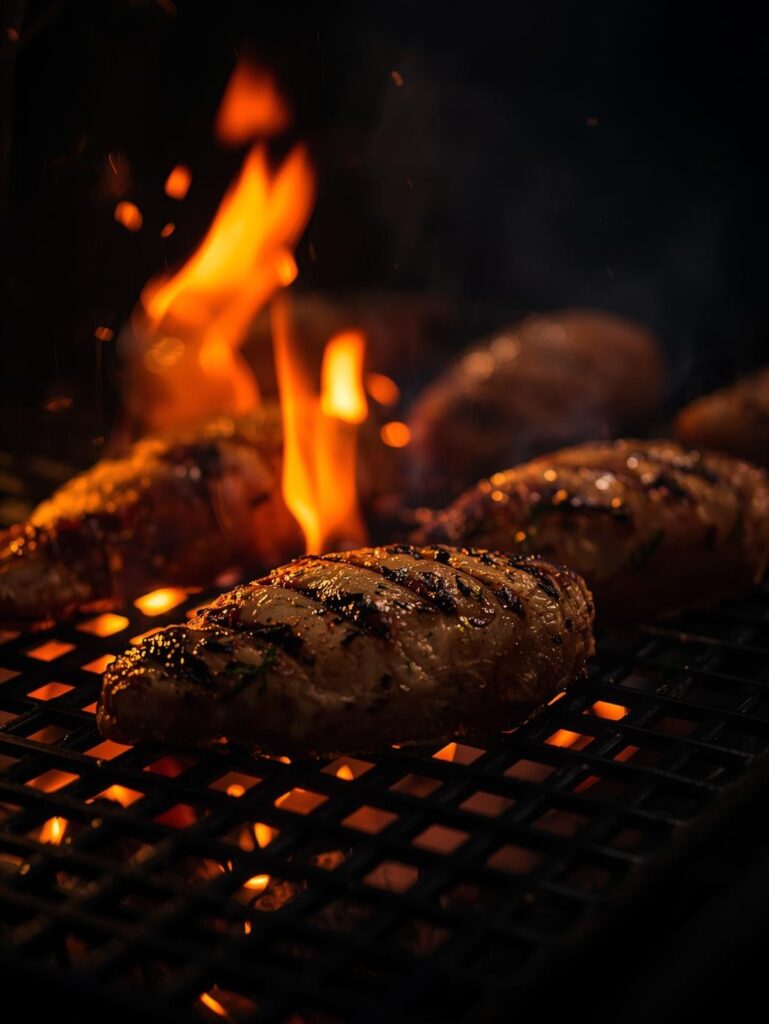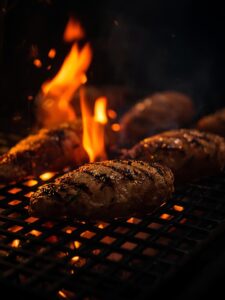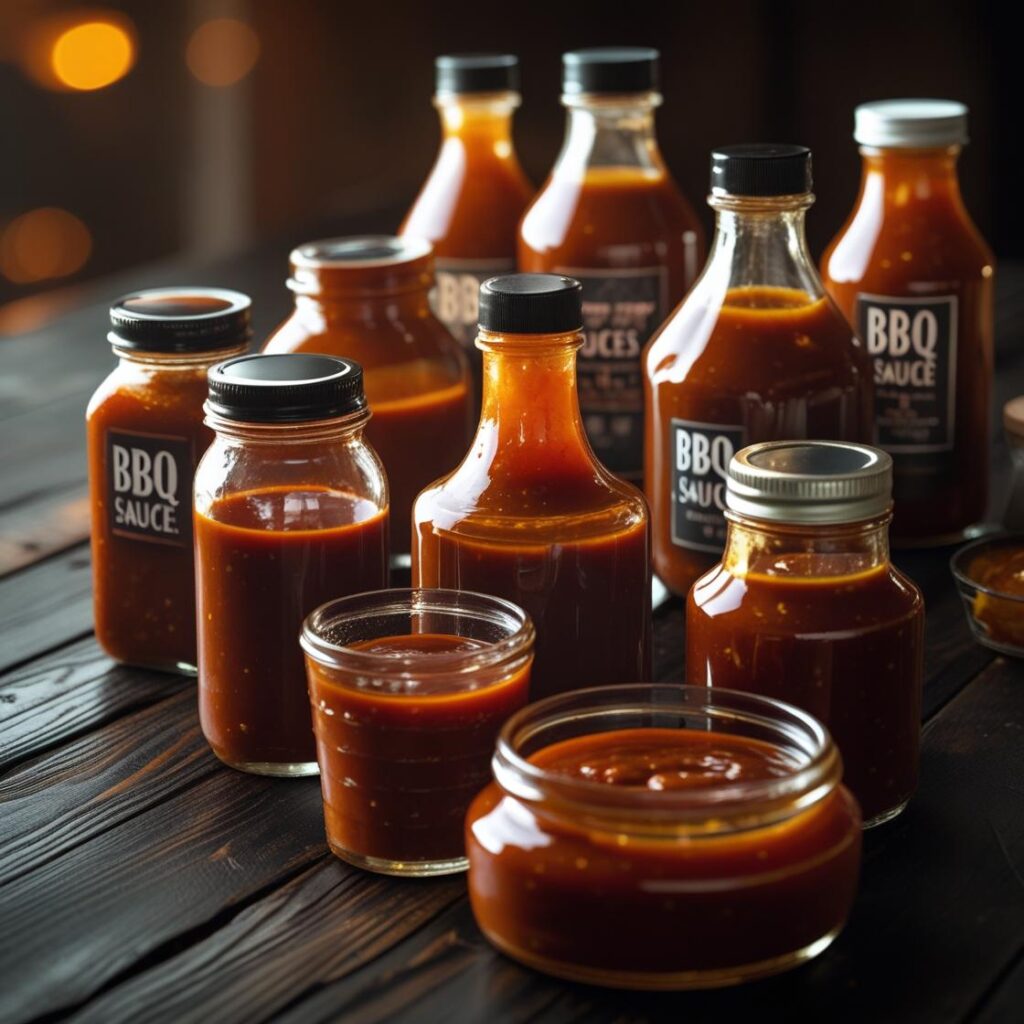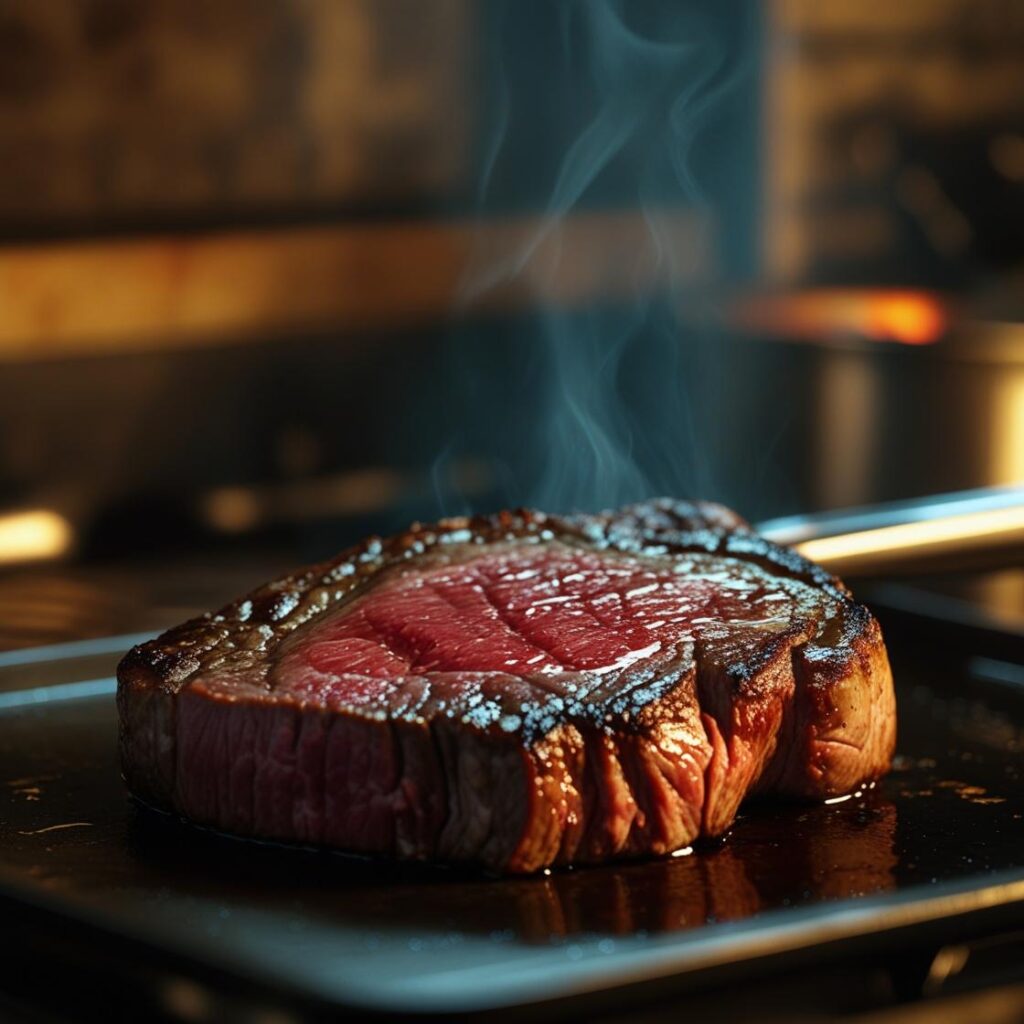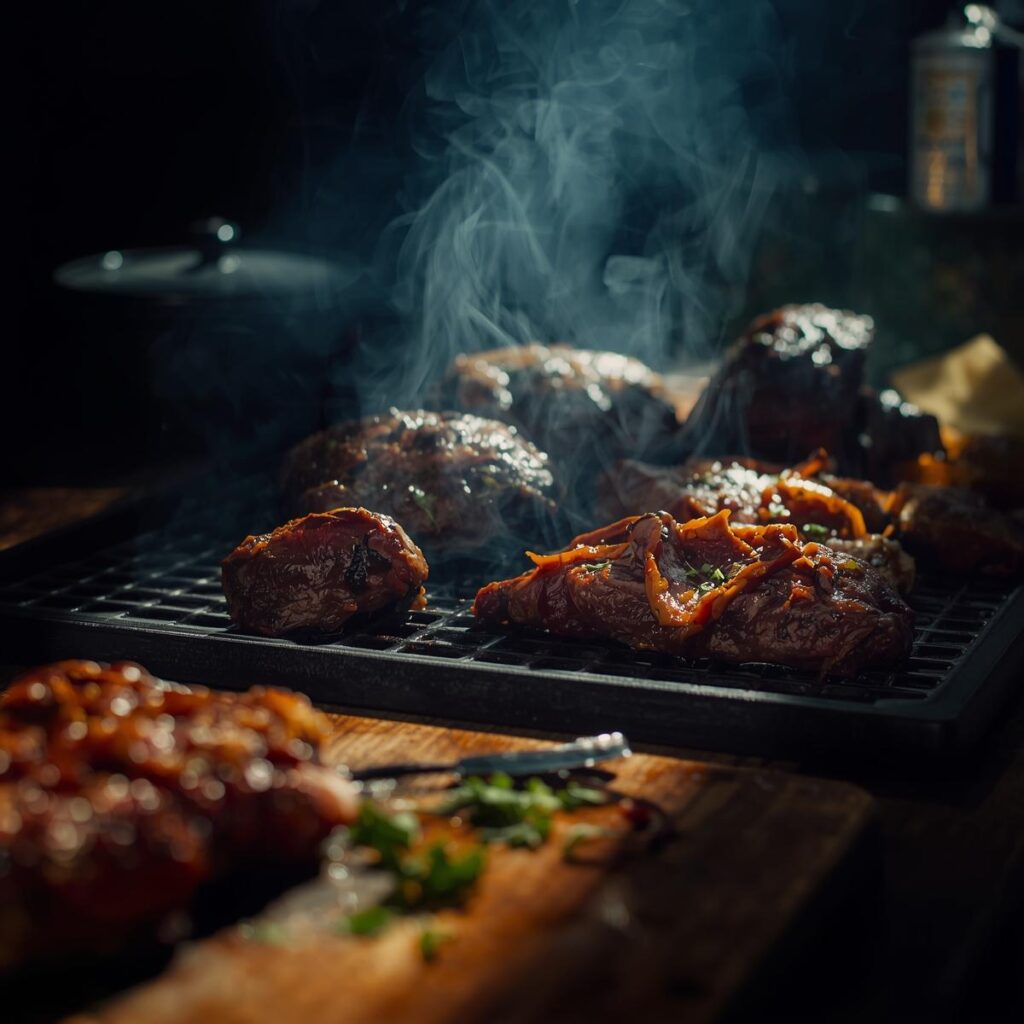Expert’s Note: This is the foundational lesson from our BBQ Methods & Techniques Encyclopedia. Mastering the difference between direct and indirect heat is what separates a novice from a true pitmaster. It is the first and most critical decision you make for any food that touches your grill.
DIRECT HEAT VS INDIRECT HEAT: THE ULTIMATE GUIDE TO GRILLING WITH CONTROL
“The single greatest mistake a griller can make is using the wrong type of heat for the wrong type of food. Direct heat is a scalpel—a fierce, focused tool for searing and marking. Indirect heat is an oven—a gentle, surrounding force for roasting and smoking. Knowing when to wield each one is the difference between a beautifully charred, juicy steak and a burnt, raw, or dried-out disappointment. This isn’t just a technique; it’s the grammar of grilling.”
Direct Heat vs. Indirect Heat: When to Use Each Grilling Method
Download our free Direct vs. Indirect Heat Quick-Reference Cheat Sheet.
Walk up to any grill, and you’ll see one cooking surface. But a master pitmaster sees two, sometimes three, distinct cooking zones. The ability to create and use these zones is what transforms grilling from a simple act of applying flame to food into a nuanced art form of temperature control. Whether you’re working with a charcoal, gas, or pellet grill, the principles of direct and indirect heat remain the universal language of fire.
This guide will demystify these core concepts. We will move beyond basic definitions and into strategic application. You will learn not just what direct and indirect heat are, but why and when to use each, how to set them up on any grill, and how to combine them for truly spectacular results. This is the knowledge that will give you complete command over your fire.
🔬 THE SCIENCE OF HEAT TRANSFER: HOW FIRE COOKS YOUR FOOD
Understanding the physics at play is the key to wielding heat effectively.
⚙️ The Three Ways Heat Moves on a Grill:
- 1. Conduction (Direct Contact): Heat transfers directly from the hot grill grates to the food sitting on them. This is the source of perfect grill marks and searing.
- 2. Convection (Hot Air Circulation): Heat is carried by the hot air and smoke swirling around the inside of the closed grill lid, cooking the food from all sides evenly. This is the principle behind your kitchen oven.
- 3. Radiation (Infrared Energy): Intense infrared energy radiates from the heat source (coals, flames, ceramic walls) directly onto the food, creating a powerful sear without direct contact.
🎯 The Core Difference Simplified:
- Direct Heat: Uses Conduction and Radiation as the primary cooking methods. The food is placed directly over the heat source.
- Indirect Heat: Uses Convection as the primary cooking method. The food is placed next to, not over, the heat source, with the lid closed.
🔥 DIRECT HEAT: THE SCORCHING SCALPEL
This is high-heat, fast cooking. The food is exposed to the full intensity of the flames or coals.
✅ What It Is:
Food is placed directly over the active heat source. On a charcoal grill, this means right over the bed of hot coals. On a gas grill, this means over the lit burners on high heat.
🎯 When to Use Direct Heat:
Use this method for foods that are: – Small & Thin: Cook quickly (under 25 minutes). – Tender: Don’t require long, slow cooking to break down. – Benefit from Searing: Need a brown, crispy crust.
Perfect For:
Steaks (for searing)
Sausages (finishing)
Pork Chops (thin-cut)
Vegetables (asparagus, zucchini)
Toasting bread
Pro Tip: The Hand Test for Direct Heat. Carefully hold your hand about 5 inches above the grill grates. If you have to pull it back in: – 2-3 seconds: High heat (perfect for searing steaks). – 4-5 seconds: Medium-high heat (great for burgers and chops). – 6-7 seconds: Medium heat (ideal for slower direct cooking).
🌡️ INDIRECT HEAT: THE GENTLE OVEN
This is low-heat, slow cooking. The food is shielded from the direct flames and cooked by the hot, circulating air inside the grill.
✅ What It Is:
The heat source is on one side of the grill, and the food is on the other. On a charcoal grill, you push the coals to one side. On a gas grill, you turn on only the left and right burners, leaving the center off. The lid must be closed to create an oven-like environment.
🎯 When to Use Indirect Heat:
Use this method for foods that are: – Large & Thick: Require longer cooking times (over 25 minutes). – Tough Cuts: Have a lot of connective tissue that needs to slowly break down. – Delicate: Would burn on the outside before cooking through on the inside.
Perfect For:
Meatloaf
Smoking Cheese (with a cold smoke attachment)
🎯 Direct vs. Indirect Heat: At a Glance
| Factor | Direct Heat | Indirect Heat |
|---|---|---|
| Grill Lid | Typically Open | Always Closed |
| Cook Time | Fast (mins) | Slow (hours) |
| Temperature | High (400°F+) | Low (225-350°F) |
| Best For | Searing, Grilling | Roasting, Smoking, Baking |
| Foods | Steaks, Burgers, Dogs | Brisket, Ribs, Whole Birds |
⚡ TWO-ZONE GRILLING: THE ULTIMATE HYBRID METHOD
This is not a separate type of heat, but the masterful combination of both direct and indirect heat on the same grill. This is the setup used by competition pitmasters and serious enthusiasts for ultimate control.
✅ How to Set Up a Two-Zone Fire:
On a Charcoal Grill: Bank all the lit hot coals to one side of the grill. This creates a hot “Direct Zone” and a cool “Indirect Zone.” On a Gas Grill: Turn on only half the burners (usually the left or right side). This creates the same two zones.
🎯 Why Two-Zone Grilling is a Game-Changer:
- Prevents Flare-Ups: If fat drips and causes a flame-up in the direct zone, you can simply move the food to the indirect zone until the flames subside.
- Perfects Thick Cuts: Cook a thick ribeye using the reverse sear method: start it slow in the indirect zone to cook evenly, then finish with a hard sear in the direct zone.
- Flexibility: You can cook different foods simultaneously. Sear steaks over direct heat while roasting vegetables indirectly.
- Safety Net: It’s the ultimate forgiveness tool. If something is cooking too fast, just slide it over.
🚨 TROUBLESHOOTING COMMON HEAT METHOD MISTAKES
🔥 “My Chicken is Burnt on the Outside and Raw in the Middle!”
Cause: Using direct heat for a thick, whole chicken. Fix: Always use indirect heat for large, whole poultry. You can finish it over direct heat for a minute or two at the end to crisp the skin if needed.
🌫️ “My Ribs Have No Bark and Taste Steamed!”
Cause: Cooking ribs over direct heat with the lid closed, or not maintaining a proper fire in an indirect setup. Fix: Use a proper indirect setup. For charcoal, ensure you have a steady, low fire. For gas, make sure the lit burners are on low to maintain a 225-275°F temperature inside the grill.
🥩 “My Steak is Grey and Tough!”
Cause: Cooking a good steak entirely with indirect heat, missing the crucial sear. Fix: For a premium steak, always use direct heat for searing. Either sear first then move to indirect to finish, or use the reverse sear method (indirect first, then a hard sear over direct at the end).
🏁 CONCLUSION: MASTER THE FIRE, MASTER THE GRILL
Direct and indirect heat are the yin and yang of grilling. One is not better than the other; they are complementary forces. The true mark of a pitmaster isn’t just knowing how to create these zones, but developing the intuition to know which one to use, and when to move food between them for a perfect result.
Your mission is this: The next time you light your grill, before you even think about food, set up a two-zone fire. Make it a habit. Practice cooking a simple sausage—sear it over direct heat, then move it to indirect to cook through without burning. This simple act will build the muscle memory and understanding that leads to a lifetime of grilling excellence.
📚 Related Techniques & Methods
- BBQ Methods & Techniques Encyclopedia – Your master resource for all foundational skills.
- Two-Zone Grilling Techniques Explained – The deep dive on the ultimate setup.
- The Reverse Sear: How to Cook the Perfect Steak – The perfect application of two-zone heat.
- How to Control Temperature in a Charcoal Grill vs. a Smoker – Taking your heat control to the next level.
Stop Burning, Start Controlling
Transform your grill from a simple firebox into a precision cooking instrument. Master direct and indirect heat and banish overcooked, undercooked, and burnt food forever.

